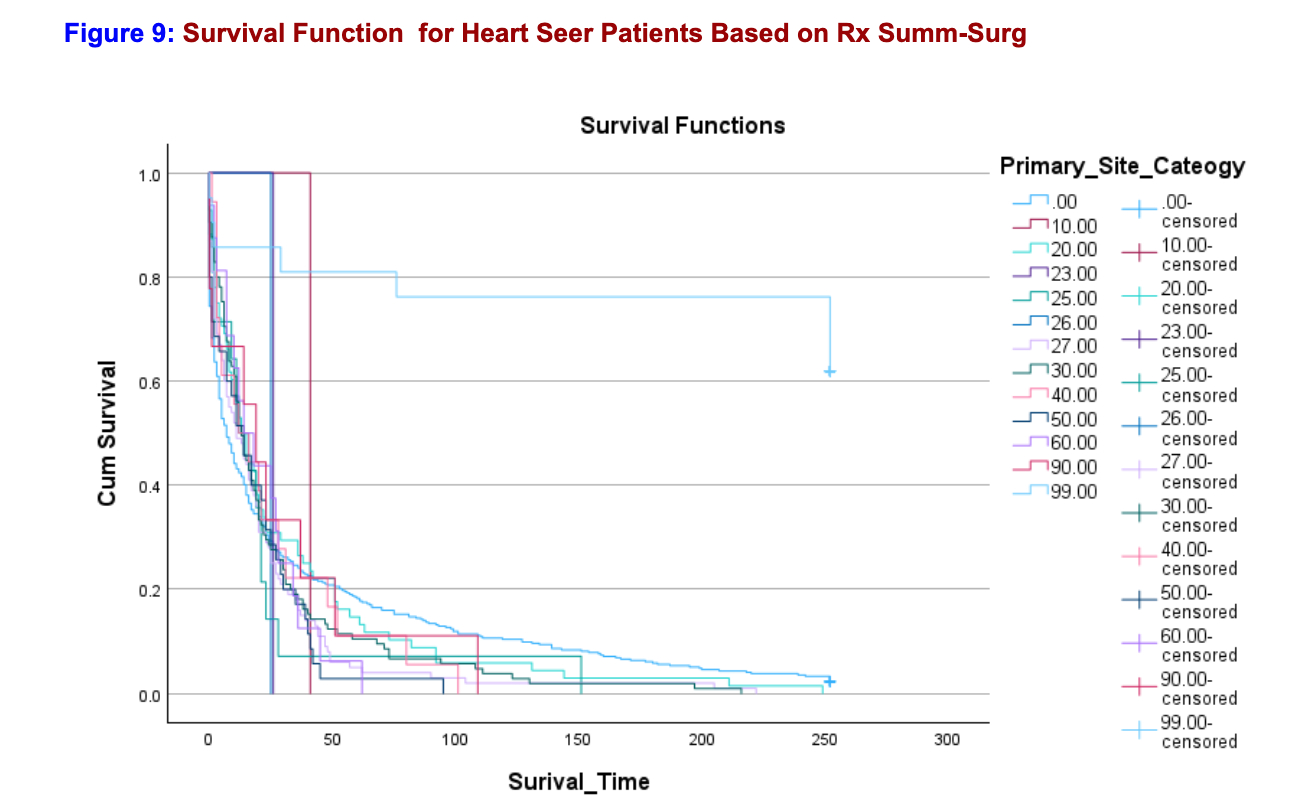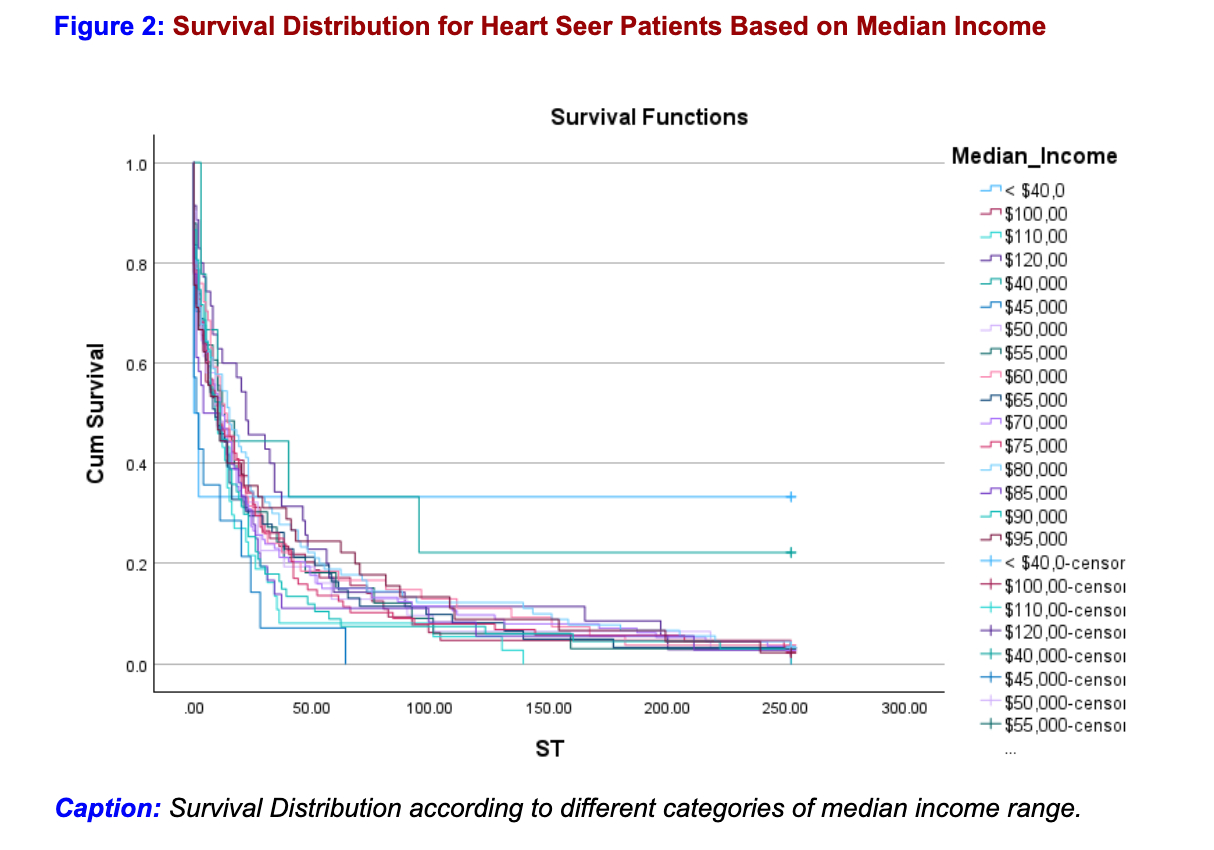Final ID: P1043
Distinct Mortality Patterns in Cancer Patients with Heart Disease: Insights from SEER Database Analysis
Abstract Body: Introduction:
Heart disease and cancer are two of the leading causes of death worldwide. The interaction between cardiovascular health, cancer, and survival outcomes is a crucial area of investigation. Thus, understanding the treatment and survival outcomes in heart disease patients who develop cancer is vital.
Hypothesis:
We assessed the hypothesis that variables such as the primary site of cancer, chemotherapy received, median income, and ICD Code, for example, resulted in different treatment outcomes of heart disease patients in the SEER database.
Methods:
The SEER database, the largest publicly available cancer registry, was used to analyze demographic and clinical data from patients diagnosed with heart disease. Variables such as SDoH, cancer diagnosis and treatment, and survival outcomes were cross-examined. Statistical analyses included Cox proportional hazards models, Poisson regression, and chi-square tests. The sample size includes 783 patients.
Results:
Survival functions showed statistical differences with a p-value <.001 in 5-year or 10-year hazard experiences based on chemotherapy received, tumor size, RX-Surgery primary site, median income, cause of death (COD), metastasis of the bone, liver, and brain, and between ICD categories, highlighting distinct interactions of these variables with pathological cardiovascular states. The highest ICD-0-3 category was patients with hemangiosarcoma at 26% of the dataset population. Poisson regression showed it was statistically significant to have higher incident rates in patients with Hemangiosarcoma than Giant Cell Carcinoma.
Chi-square tests for impact on COD showed it was statistically significant that each pairing of the primary site of cancer, chemotherapy received, median income, RX-Surgery primary site, metastasis of the bone, liver, and brain, and ICD Code combined with COD were different. With the observed frequencies different from expected with a p-value of <.001, this study prompts further investigation into the distinct mortality patterns that involve the interplay of cardiovascular complications and cancer progression.
Conclusions:
The results demonstrate tangible differences in mortality patterns of heart SEER patients based on many factors. Understanding these relationships is crucial to developing targeted clinical strategies and preventative measures. Future research should strive to foster a better understanding of pathologic cardiovascular conditions and how they interact with cancer states.
Heart disease and cancer are two of the leading causes of death worldwide. The interaction between cardiovascular health, cancer, and survival outcomes is a crucial area of investigation. Thus, understanding the treatment and survival outcomes in heart disease patients who develop cancer is vital.
Hypothesis:
We assessed the hypothesis that variables such as the primary site of cancer, chemotherapy received, median income, and ICD Code, for example, resulted in different treatment outcomes of heart disease patients in the SEER database.
Methods:
The SEER database, the largest publicly available cancer registry, was used to analyze demographic and clinical data from patients diagnosed with heart disease. Variables such as SDoH, cancer diagnosis and treatment, and survival outcomes were cross-examined. Statistical analyses included Cox proportional hazards models, Poisson regression, and chi-square tests. The sample size includes 783 patients.
Results:
Survival functions showed statistical differences with a p-value <.001 in 5-year or 10-year hazard experiences based on chemotherapy received, tumor size, RX-Surgery primary site, median income, cause of death (COD), metastasis of the bone, liver, and brain, and between ICD categories, highlighting distinct interactions of these variables with pathological cardiovascular states. The highest ICD-0-3 category was patients with hemangiosarcoma at 26% of the dataset population. Poisson regression showed it was statistically significant to have higher incident rates in patients with Hemangiosarcoma than Giant Cell Carcinoma.
Chi-square tests for impact on COD showed it was statistically significant that each pairing of the primary site of cancer, chemotherapy received, median income, RX-Surgery primary site, metastasis of the bone, liver, and brain, and ICD Code combined with COD were different. With the observed frequencies different from expected with a p-value of <.001, this study prompts further investigation into the distinct mortality patterns that involve the interplay of cardiovascular complications and cancer progression.
Conclusions:
The results demonstrate tangible differences in mortality patterns of heart SEER patients based on many factors. Understanding these relationships is crucial to developing targeted clinical strategies and preventative measures. Future research should strive to foster a better understanding of pathologic cardiovascular conditions and how they interact with cancer states.
More abstracts on this topic:
5-oxoproline/ OPLAH Axis Alleviates Doxorubicin-induced Cardiomyopathy By Inhibiting Ferroptosis
Jiang Meng, Guo Xinning
An Electronic Health Record Multimodal Data Integration Platform for Comprehensive Analysis of Single Ventricle PhysiologyXu Hang, Aboulhosn Jamil, Christodoulou Anthony, Finn Paul, Hsu William, Nguyen Kimlien, Zhang Hinn, Sisniega Carlos, Renella Pierangelo, Morris Connor, Husain Majid, Satou Gary, Zhu Bing, Van Arsdell Glen


